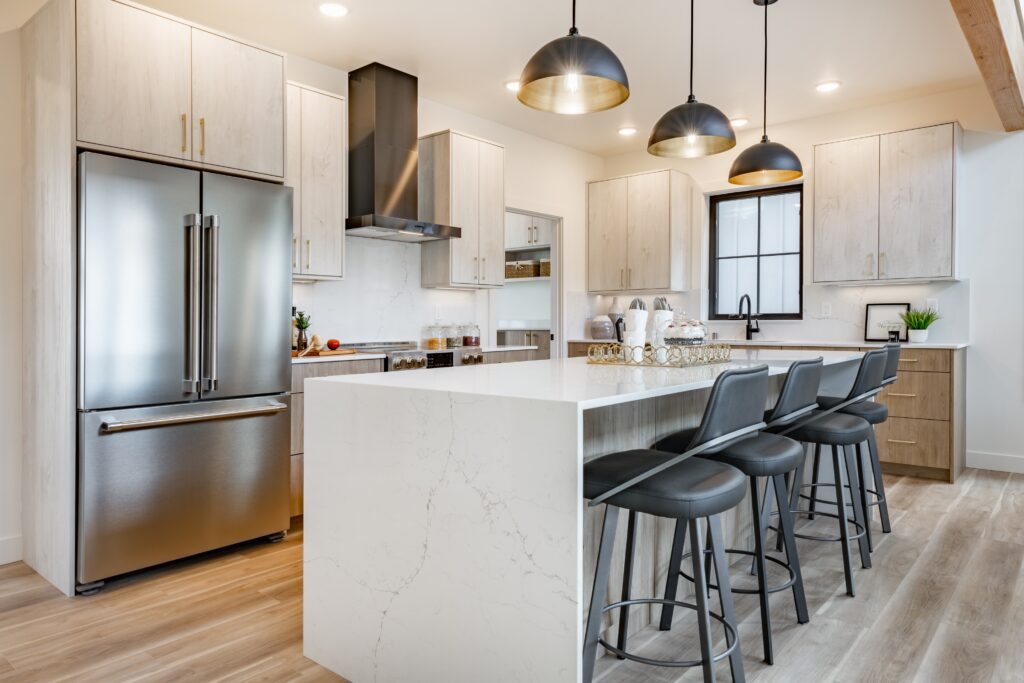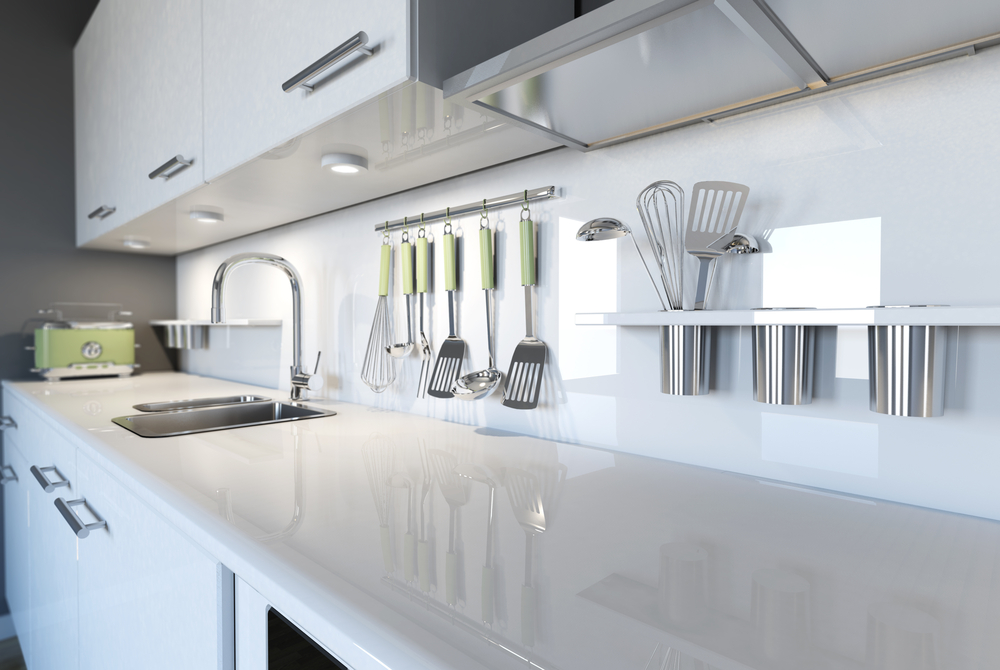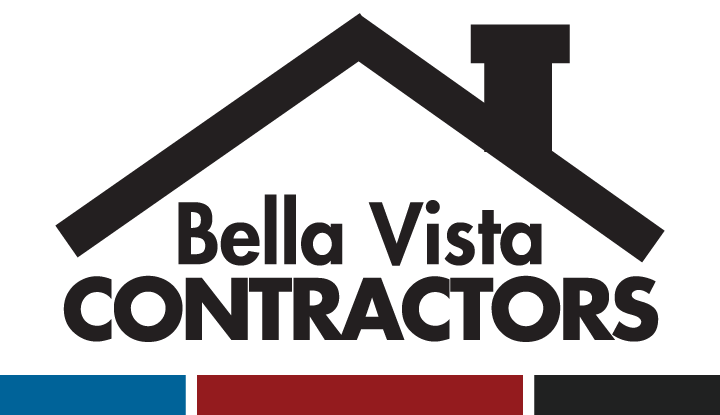Are you tired of cooking in a dimly lit kitchen? Looking to brighten up your culinary space and create a warm and inviting atmosphere? Look no further! In this article, we will share some valuable tips for choosing the perfect kitchen lighting.

The right lighting can transform your kitchen into a functional and stylish space. It not only enhances visibility but also adds personality and ambiance to your cooking area. From pendant lights to recessed lighting, there is a wide variety of options to choose from. But how do you know which ones are right for your kitchen?
We’ve got you covered. Whether you have a small galley kitchen or a spacious open-concept design, we will guide you through the process of selecting the ideal lighting fixtures. We will discuss the importance of task lighting, ambient lighting, and accent lighting, and how they can work together to create a well-lit and visually appealing space.
Get ready to say goodbye to dull and lackluster kitchen lighting. Let’s explore the world of kitchen lighting and discover the perfect lighting solution for your culinary space.
Importance of kitchen lighting
Good kitchen lighting is essential for both functionality and aesthetics. A well-lit kitchen enhances the cooking experience, allowing you to prepare meals with precision. When you’re chopping vegetables or reading a recipe, proper illumination helps reduce the risk of accidents and mistakes. Bright light can illuminate every corner of your culinary space, ensuring that no surface is left in the shadows. This is particularly important in areas where detailed work occurs, such as countertops and islands.
Additionally, lighting can significantly affect the ambiance of your kitchen. A warm, inviting glow can make the space feel cozy and comfortable, encouraging family gatherings and social interactions. On the other hand, harsh lighting can create an unwelcoming environment that detracts from the enjoyment of cooking and dining. Choosing the right lighting can transform your kitchen into a hub of activity, where family and friends gather to share meals and memories.
Moreover, the right lighting enhances the overall design of your kitchen. It can highlight architectural features, showcase beautiful countertops, or draw attention to vibrant backsplash tiles. Thoughtfully designed lighting can serve as a focal point, adding personality and style to your culinary space. This makes kitchen lighting not just a functional necessity, but also an integral part of your home’s décor.
Types of kitchen lighting fixtures
When it comes to choosing kitchen lighting, understanding the various types of fixtures available is crucial. Each type serves a specific purpose and can be used in different areas of the kitchen. Pendant lights, for instance, are popular choices for islands or dining areas. They come in a variety of styles, shapes, and sizes, making them versatile for both modern and traditional kitchens. Hanging them at varying heights can create visual interest while providing focused illumination where it’s needed most.
Recessed lights, or can lights, offer a sleek, unobtrusive option that works well for ambient lighting. Installed into the ceiling, they provide a clean look and can be strategically placed to eliminate shadows in work areas. This type of lighting is particularly effective in smaller kitchens where space is at a premium. Additionally, track lighting can be adjusted to direct light where it’s needed, making it a flexible option for illuminating different sections of the kitchen.
Under-cabinet lighting is another essential fixture that enhances functionality. Illuminating countertops directly allows for better visibility while preparing food and can highlight beautiful cabinetry. This type of lighting can be integrated seamlessly into the kitchen design, providing both practicality and elegance. Mixing and matching these various types of fixtures can create a layered lighting effect, essential for achieving the perfect balance in your kitchen.
Understanding different lighting options – ambient, task, and accent lighting
To create a well-lit kitchen, it’s important to understand the three primary types of lighting: ambient, task, and accent. Ambient lighting is the general illumination that fills the entire kitchen. This is typically provided by overhead fixtures such as chandeliers or ceiling-mounted lights. The goal of ambient lighting is to provide a comfortable level of brightness that allows you to navigate the kitchen safely and comfortably.
Task lighting, on the other hand, is more focused and is designed to illuminate specific areas where tasks are performed. This includes areas like countertops, stoves, and sinks. Pendant lights or under-cabinet fixtures are excellent choices for task lighting, as they provide direct light where it’s needed most. Good task lighting not only enhances visibility but also reduces strain on the eyes, making cooking and food preparation more enjoyable.
Lastly, accent lighting is used to highlight specific features or areas within your kitchen. This could include showcasing artwork, illuminating a beautiful backsplash, or drawing attention to unique architectural details. Accent lighting adds depth and character to the kitchen, contributing to an overall inviting atmosphere. By combining ambient, task, and accent lighting, you can create a layered lighting scheme that enhances both functionality and aesthetics in your culinary space.
Factors to consider when choosing kitchen lighting
When selecting kitchen lighting, several critical factors should guide your decision-making process. One of the foremost considerations is the size of your kitchen. Larger spaces may require multiple light sources to ensure even illumination, while smaller kitchens might benefit from fewer, more strategically placed fixtures. The layout of your kitchen also plays a significant role; open-concept designs may necessitate different lighting strategies compared to enclosed spaces.
Another important factor is the style and décor of your kitchen. Your lighting fixtures should complement the overall design aesthetic, whether it be modern, rustic, or traditional. For instance, sleek metallic fixtures may work well in contemporary kitchens, while vintage-style lighting can enhance a more traditional setting. Aligning your lighting choices with the kitchen’s design will create a cohesive look that enhances the overall atmosphere.
Furthermore, consider the color temperature of the light bulbs you choose. Warm white bulbs create a cozy, inviting glow, making them perfect for creating a welcoming kitchen ambiance. In contrast, cool white or daylight bulbs provide a brighter, more energizing light that can be beneficial for task-oriented areas. Balancing these factors will help you create a well-lit kitchen that is both beautiful and functional.
Tips for choosing the perfect lighting fixtures
Choosing the perfect lighting fixtures for your kitchen involves a blend of personal style and practical considerations. Start by identifying the primary functions of your kitchen. Is it primarily a cooking space, or do you also entertain guests? Understanding how you use the space will help you choose fixtures that meet your specific needs. For example, if you often host dinner parties, consider incorporating adjustable dimmers to control the brightness and set the mood.
Next, think about the scale of the fixtures about your kitchen size. Large, bold pendant lights can make a stunning statement in a spacious kitchen, while smaller fixtures may be more suitable for compact spaces. When hanging fixtures above islands or dining tables, ensure they are positioned at the right height to provide adequate lighting without obstructing views. A general rule of thumb is to hang pendants about 30 to 36 inches above the countertop or tabletop.
Lastly, don’t overlook the importance of energy efficiency. Opt for LED bulbs, which consume less energy and last longer than traditional incandescent bulbs. When choosing fixtures, look for those labeled with energy-efficient ratings. This not only helps you save on electricity bills but also reduces your environmental footprint. Emphasizing sustainability in your lighting choices can contribute to a more conscientious home environment while still achieving a beautifully illuminated kitchen.

Lighting placement and arrangement in the kitchen
Proper lighting placement is crucial for maximizing both functionality and aesthetics in the kitchen. Start by assessing the layout of your space. Identify key areas where tasks are performed, such as the cooking zone, prep areas, and dining spaces. These zones should receive adequate task lighting to ensure safety and efficiency. For instance, under-cabinet lights should be installed directly above countertops to eliminate shadows while cooking.
In addition to task areas, consider the overall flow of the kitchen. Ambient lighting should be evenly distributed to avoid dark corners. Recessed lighting can be an excellent choice for general illumination, as it can be placed strategically throughout the ceiling to create a uniform glow. Remember to include lighting over dining areas, whether it’s a simple pendant above a table or a series of fixtures along an island.
Finally, don’t forget about accent lighting. This type of lighting should be used to highlight features that add character to your kitchen. Whether it’s showcasing beautiful cabinetry, decorative tiles, or artwork, accent lighting can bring your kitchen to life. Using adjustable fixtures allows you to change the focus as your taste evolves or as you update your decor. Thoughtful placement and arrangement of lighting can transform your kitchen into a beautifully illuminated space that meets all your culinary needs.
Incorporating natural light into your kitchen design
Natural light can dramatically enhance the atmosphere of your kitchen, making it feel more open and inviting. When designing your kitchen, consider ways to maximize the amount of natural light that enters the space. Large windows are an excellent option, allowing sunlight to flood in during the day. If your kitchen has limited window space, consider installing a skylight or solar tube to bring in additional light from above.
In addition to maximizing windows, think about the color palette and materials used in your kitchen. Light-colored walls and reflective surfaces can help bounce natural light around the room, further brightening the space. For instance, glossy finishes on cabinets or countertops can enhance the effect of sunlight, making the kitchen feel airy and spacious.
Moreover, strategically placing mirrors can also amplify natural light. A well-placed mirror can reflect light from windows, creating the illusion of a larger space while brightening the overall ambiance. By thoughtfully incorporating natural light into your kitchen design, you can create a warm, inviting environment that elevates your culinary experience.
Energy-efficient kitchen lighting options
With growing awareness of environmental issues, energy-efficient lighting options have become increasingly popular in kitchen design. LED bulbs are among the most energy-efficient choices available today. They consume significantly less energy than traditional incandescent bulbs and have a much longer lifespan, often lasting up to 25,000 hours. By making the switch to LED lighting, you can reduce your energy consumption and save on utility bills.
In addition to LED bulbs, consider incorporating dimmer switches into your lighting design. Dimmers allow you to adjust the brightness of your fixtures, providing flexibility depending on the time of day or occasion. Lowering the light level can create a cozy atmosphere during dinner parties, while brighter settings can be ideal for food preparation. This adaptability not only enhances the kitchen experience but also contributes to energy savings.
Finally, look for fixtures that are specifically designed for energy efficiency. Many manufacturers now offer products that meet strict energy efficiency guidelines. These fixtures often use advanced technologies, such as integrated LED lighting, to provide optimal illumination while minimizing energy use. By selecting energy-efficient options, you can create a stylish kitchen that is also environmentally friendly, ensuring a sustainable culinary space for the future.
Maintenance and care for kitchen lighting fixtures
Proper maintenance and care of your kitchen lighting fixtures are essential for ensuring their longevity and functionality. Regular cleaning is a key aspect of this process. Dust and grime can accumulate on fixtures, dulling their appearance and reducing their effectiveness. Use a soft, damp cloth to gently wipe down surfaces, being careful not to damage any delicate components. For fixtures with glass shades, a mixture of warm water and mild detergent can help restore their clarity.
Another important consideration is bulb replacement. Regularly check your bulbs to ensure they are functioning properly. If you notice flickering lights or burnt-out bulbs, replace them promptly to maintain consistent illumination. When replacing bulbs, choose the same wattage and type to ensure compatibility with your fixtures. Keeping track of the lifespan of your bulbs can help you stay ahead of replacements and avoid unexpected outages.
Finally, inspect your fixtures periodically for any signs of damage or wear. Loose connections or frayed wires can pose safety hazards, so addressing these issues promptly is essential. If you notice any problems, consider consulting a professional electrician to ensure safe repairs. By committing to regular maintenance and care, you can keep your kitchen lighting fixtures in excellent condition, enhancing both their appearance and functionality for years to come.

Conclusion: Transforming your culinary space with the right kitchen lighting
In conclusion, the right kitchen lighting can profoundly impact both the functionality and ambiance of your culinary space. By understanding the importance of lighting, the various types of fixtures available, and how to effectively combine ambient, task, and accent lighting, you can create a well-lit environment that meets all your needs.
When choosing lighting fixtures, consider factors such as kitchen size, design style, and energy efficiency. Thoughtful placement and arrangement of lights can maximize their effectiveness while incorporating natural light can further enhance the space. Regular maintenance and care will ensure your lighting remains beautiful and functional for years to come.
Ultimately, investing time and effort into selecting the right kitchen lighting will transform your culinary space into a warm, inviting area where cooking becomes a joy and gatherings are cherished. With the right mix of lighting, your kitchen can truly shine, reflecting your style and enhancing the overall ambiance of your home.
